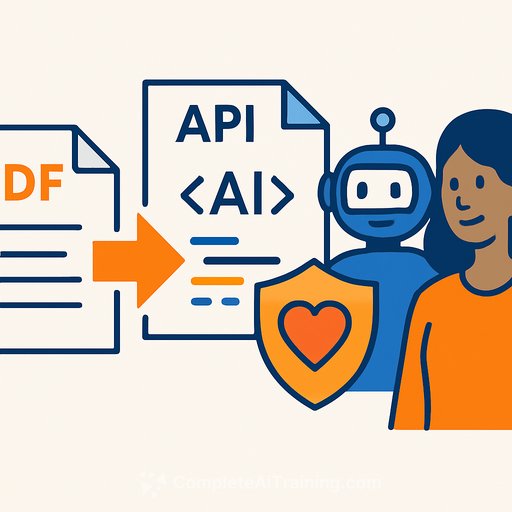AI for Life Insurance Customer Experience: From Adoption to Acceleration
AI is past the pilot phase. The mandate now is to speed up delivery, improve customer experience, and remove blockers in legacy tech that slow everything down.
Mindy Chen, vice president of segment analytics at Mutual of Omaha, is building enterprise generative AI and agentic systems. Her view is blunt: AI can help insurers serve customers in new ways, but only if your systems are built so AI can actually use them.
Takeaways
- The conversation has moved from adoption to acceleration.
- AI can extend how insurers assist customers across the journey.
- Legacy systems built for human use - not AI - will create friction and cost.
What Agentic AI Changes for Insurers
Agentic AI isn't limited to chat. It can observe, reason, and act across systems. That shifts value from "a better interface" to "end-to-end task completion" - quoting, underwriting support, service workflows, and agent enablement.
That promise breaks if AI can't read your data, access your logic, or trigger actions. The core job: make systems AI-operable, not just human-operable.
Knowledge Transfer From Legacy Code
Modern AI tools can crawl legacy codebases and data stores to map dependencies, extract business logic, and auto-generate documentation and tests. This speeds modernization, reduces risk, and helps new developers understand what they're inheriting.
Think of it as "x-ray vision" for old systems: what functions do, what relies on what, and which rules can be lifted out so you can retire brittle modules with confidence.
The Talent Stack You Need
Enterprise AI work benefits from a blended profile: data scientist plus full-stack developer. You need people who can design experiments, measure bias and fairness, and evaluate non-deterministic models - and also integrate services, ship features, and manage APIs and events.
Workload swings across phases: data wrangling one month, app integration the next, evaluation at scale after that. One person who spans both disciplines often outperforms two siloed roles.
AI can write code fast. Your competitive edge becomes specifying the right thing to build. That puts a premium on product management, stakeholder communication, and user empathy across agents, CSRs, underwriters, and claims specialists.
How to Build Those Skills
For new grads and upskilling teams, focus on product skills as much as model skills. Learn to interview users, shadow workflows, and translate needs into clear problem statements and specs.
Don't wait for users to hand you solutions. Observe tasks, constraints, and outcomes; then propose options the business hasn't considered. That is how you ensure AI builds the right thing, not just anything.
Strategic Capabilities to Fund Now
AI can't help if it can't see what you see. Many carriers store key information in PDFs, screens, or tightly coupled applications that were built for human eyes and clicks, not machine access.
Invest in AI-ready operational systems: store data in machine-readable formats (e.g., JSON or XML), expose complete APIs, and decouple business logic from presentation. Vision models can read PDFs and LLMs can "look" at screens, but those paths are slower and often more expensive at scale.
Standardize your interface layer. An OpenAPI-first approach makes AI integration, testing, and governance far easier across policy, claims, billing, and distribution.
Budget Framing That Works
Raise awareness that your "AI coworker" needs the same data and actions your people have. If it only sees a tenth of the data, it will only help with a tenth of the work.
Fund the enablers: data availability, APIs, event streams, and observable services. Make the case that these investments pay off across use cases - not just one pilot - and reduce future integration costs.
Practical Next Steps
- Inventory critical processes and surfaces (PDFs, screens, batch jobs). Prioritize high-volume, high-friction steps in customer and agent journeys.
- Use code-crawling and documentation tools to extract business rules from legacy modules. Target logic that blocks automation or creates rework.
- Adopt an API-first policy admin, claims, and billing strategy with versioned endpoints, consistent auth, and eventing for downstream triggers.
- Set up an evaluation framework for prompts, models, and guardrails. Track accuracy, coverage, latency, cost, bias, and regression over time.
- Build a blended team: full-stack developers with data science experience, plus product managers who sit with users and own outcomes.
- Establish bias/fairness testing practices aligned to the NIST AI Risk Management Framework.
Upskilling Resources
- AI courses by job role for structured learning paths across product, data, and engineering.
The Bottom Line for Insurers
Acceleration depends less on model choice and more on system readiness, talent mix, and product discipline. Make your data and logic accessible, build blended teams, measure outcomes, and ship improvements in short cycles.
Do that, and AI moves from demo to daily production - where it helps agents sell better, resolves service issues faster, and gives customers a smoother experience end to end.
Your membership also unlocks:






